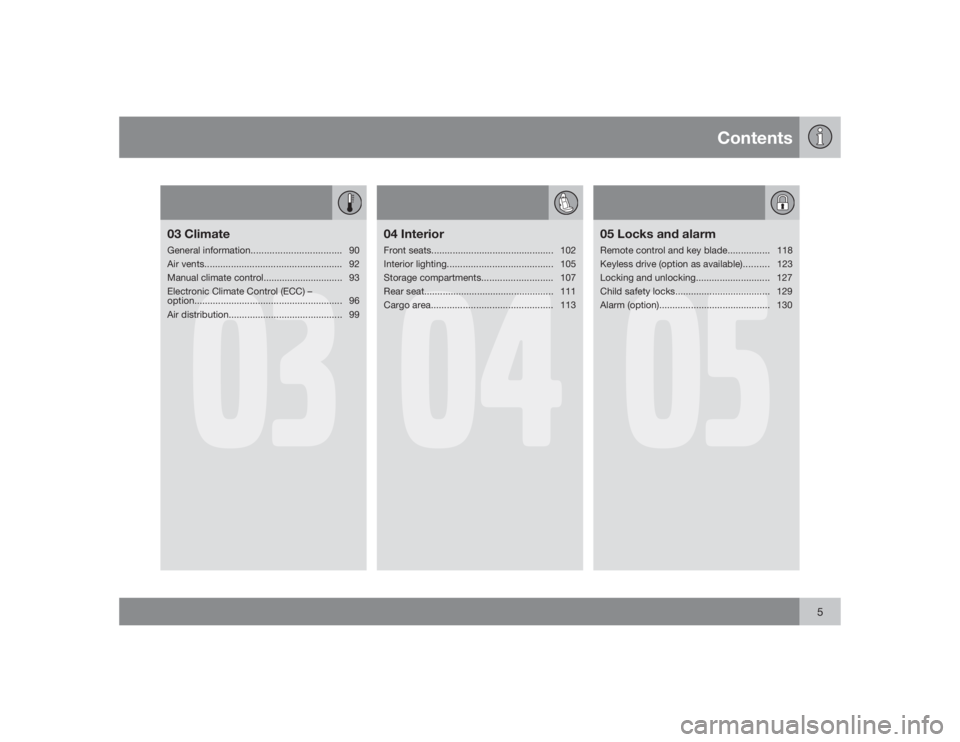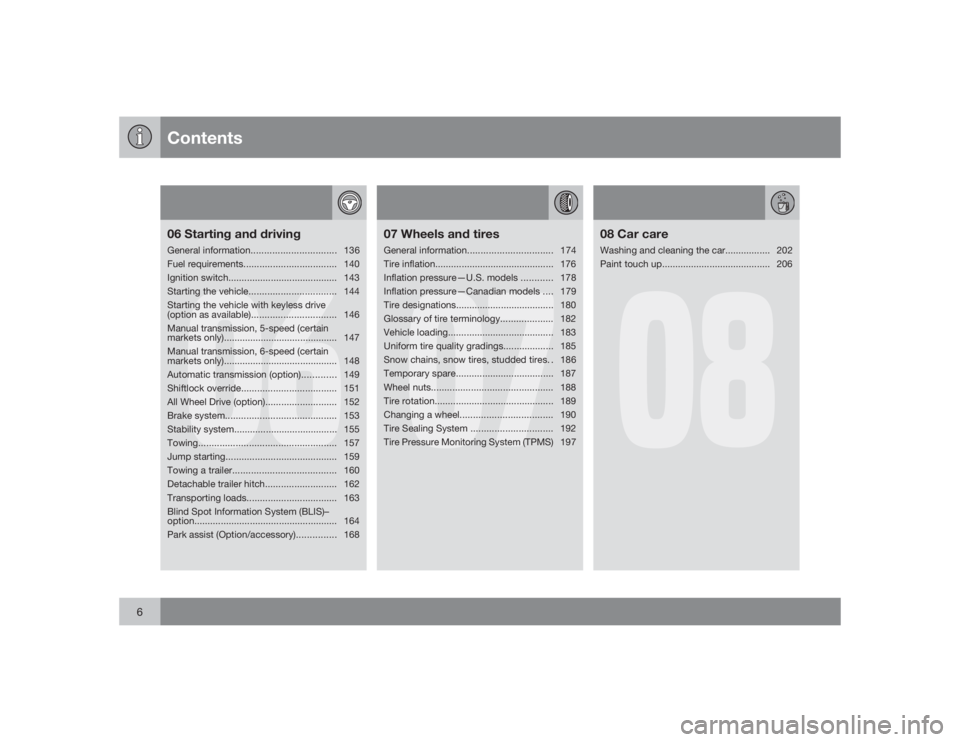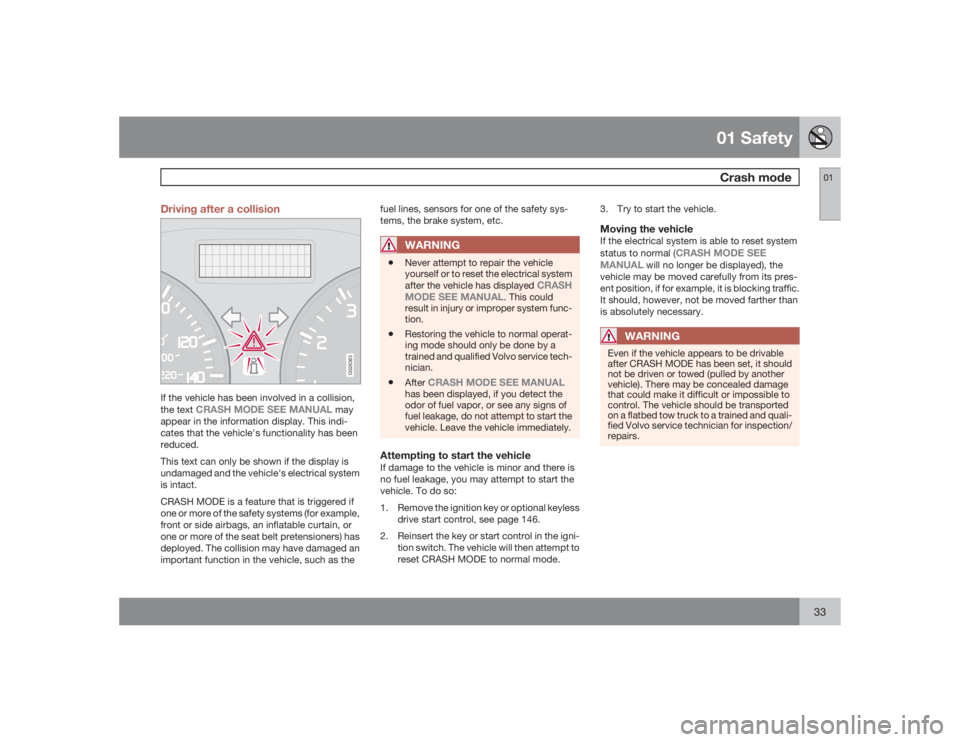2009 VOLVO V50 lock
[x] Cancel search: lockPage 5 of 286

Contents
5
03
03 ClimateGeneral information.................................. 90
Air vents.................................................... 92
Manual climate control.............................. 93
Electronic Climate Control (ECC) –
option........................................................ 96
Air distribution........................................... 99
04
04 InteriorFront seats.............................................. 102
Interior lighting........................................ 105
Storage compartments........................... 107
Rear seat................................................. 111
Cargo area.............................................. 113
05
05 Locks and alarmRemote control and key blade................118
Keyless drive (option as available).......... 123
Locking and unlocking............................ 127
Child safety locks.................................... 129
Alarm (option).......................................... 130
Page 6 of 286

Contents
6
06
06 Starting and drivingGeneral information................................136
Fuel requirements................................... 140
Ignition switch......................................... 143
Starting the vehicle................................. 144
Starting the vehicle with keyless drive
(option as available)................................ 146
Manual transmission, 5-speed (certain
markets only)........................................... 147
Manual transmission, 6-speed (certain
markets only)........................................... 148
Automatic transmission (option)............. 149
Shiftlock override.................................... 151
All Wheel Drive (option)........................... 152
Brake system.......................................... 153
Stability system....................................... 155
Towing.................................................... 157
Jump starting.......................................... 159
Towing a trailer....................................... 160
Detachable trailer hitch........................... 162
Transporting loads.................................. 163
Blind Spot Information System (BLIS)–
option...................................................... 164
Park assist (Option/accessory)............... 168
07
07 Wheels and tiresGeneral information................................174
Tire inflation............................................. 176
Inflation pressure—U.S. models ............ 178
Inflation pressure—Canadian models .... 179
Tire designations..................................... 180
Glossary of tire terminology.................... 182
Vehicle loading........................................ 183
Uniform tire quality gradings................... 185
Snow chains, snow tires, studded tires. . 186
Temporary spare..................................... 187
Wheel nuts.............................................. 188
Tire rotation............................................. 189
Changing a wheel................................... 190
Tire Sealing System ............................... 192
Tire Pressure Monitoring System (TPMS) 197
08
08 Car careWashing and cleaning the car................. 202
Paint touch up......................................... 206
Page 10 of 286

IntroductionGeneral information
10
Shiftlock (automatic transmission)When your car is parked, the gear selector is
locked in the Park (P) position. To release the
selector from this position, turn the ignition key
to position II (or start the engine), depress the
brake pedal, press the button on the front side
of the gear selector and move the selector from
Park (P).Keylock (automatic transmission)When the ignition is switched off, the gear
selector must be in the Park (P) position before
the key can be removed from the ignition
switch.Anti-lock Brake System (ABS)The ABS system in your car performs a self-
diagnostic test when the vehicle first reaches
the speed of approximately 12 mph
(20 km/h). The brake pedal will pulsate several
times and a sound may be audible from the
ABS control module. This is normal.Fuel filler doorPress the button on the light switch panel when
the car is at a standstill to open the fuel filler
door.Fuel filler capAfter refueling, close the fuel filler cap by turn-
ing it clockwise until it clicks into place. If this
cap is not closed tightly or if the engine is run-
ning when the car is refueled, the MalfunctionIndicator Lamp ("Check Engine" light) may
indicate a fault.
About this manual•
Before you operate your vehicle for the first
time, please familiarize yourself with the
new-engine oil consumption information,
see page 216. You should also be familiar
with the information found in the chapters
"Instruments and controls", and "Starting
and driving".
•
Information contained in the balance of the
manual is extremely useful and should be
read after operating the vehicle for the first
time.
•
The manual is structured so that it can be
used for reference. For this reason, it
should be kept in the vehicle for ready
access.
NOTE
•
Optional or accessory equipment
described in this manual may not be
available in all countries or markets.
Please note that some vehicles may be
equipped differently, depending on
special legal requirements.
•
All information, illustrations and specifi-
cations contained in this manual are
based on the latest product information
available at the time of publication.
•
Volvo reserves the right to make model
changes at any time, or to change spec-
ifications or design without notice and
without incurring obligation.
•
Do not export your Volvo to another
country before investigating that coun-
try's applicable safety and emission
control requirements. In some cases it
may be difficult or impossible to comply
with these requirements. Modifications
to the emission control system(s) may
render your Volvo not certifiable for
legal operation in the U.S., Canada and
other countries.
Page 18 of 286

01 SafetySeat belts
0118
Using seat belts
G020104
Adjusting the seat beltSeat belts should always be worn by all occu-
pants of your vehicle. Children should be prop-
erly restrained, using an infant, car, or booster
seat determined by age, weight and height.
Volvo also believes no child should sit in the
front seat of a vehicle.
Most states and provinces make it mandatory
for occupants of a vehicle to use seat belts.Seat belt pretensionersThe outboard seat belts are equipped with pre-
tensioners that reduce slack in the belts. These
pretensioners are triggered in situations where
the front or side impact airbags deploy, and incertain impacts from the rear. The front seat
belts also include a tension reducing device
which, in the event of a collision, limits the peak
forces exerted by the seat belt on the occu-
pant.
Buckling a seat beltPull the belt out far enough to insert the latch
plate into the receptacle until a distinct click is
heard. The seat belt retractor is normally
"unlocked" and you can move freely, provided
that the shoulder belt is not pulled out too far.
The retractor will lock up as follows:•
if the belt is pulled out rapidly
•
during braking and acceleration
•
if the vehicle is leaning excessively
•
when driving in turns
When wearing the seat belt remember:•
The belt should not be twisted or turned.
•
The lap section of the belt must be posi-
tioned low on the hips (not pressing against
the abdomen).
•
Make sure that the shoulder belt is rolled
up into its retractor and that the shoulder
and lap belts are taut.
Unbuckling the seat belt•
To remove the seat belt, press the red sec-
tion on the seat belt receptacle. Before
exiting the vehicle, check that the seat beltretracts fully after being unbuckled. If nec-
essary, guide the belt back into the retrac-
tor slot.
WARNING
Never use a seat belt for more than one
occupant. Never wear the shoulder portion
of the belt under the arm, behind the back
or otherwise out of position. Such use could
cause injury in the event of an accident. As
seat belts lose much of their strength when
exposed to violent stretching, they should
be replaced after any collision, even if they
appear to be undamaged.
Page 21 of 286

01 Safety
Supplemental Restraint System
01�`�`21 Supplemental Restraint System (SRS)
G026330
SRS warning lightAs an enhancement to the three-point seat
belts, your Volvo is equipped with a Supple-
mental Restraint System (SRS). Volvo's SRS
consists of seat belt pretensioners, front air-
bags, side impact airbags, the occupant
weight sensor, and inflatable curtains. All of
these systems are monitored by the SRS con-
trol module. An SRS warning light in the instru-
ment panel (see the illustration) illuminates
when the ignition key is turned to position I,II,
orIII, and will normally go out after approxi-
mately 7 seconds if no faults are detected in
the system.Where applicable, a text message will also be
displayed when the SRS warning light illumi-
nates. If this warning symbol is not functioning
properly, the general warning symbol
illuminates and either
SRS AIRBAG
SERVICE URGENT
or
SRS AIRBAG
SERVICE REQUIRED will be displayed.
WARNING
•
If the SRS warning light stays on after
the engine has started or if it illuminates
while you are driving, have the vehicle
inspected by a trained and qualified
Volvo service technician as soon as
possible.
•
Never try to repair any component or
part of the SRS yourself. Any interfer-
ence in the system could cause mal-
function and serious injury. All work on
these systems should be performed by
a trained and qualified Volvo service
technician.
WARNING
If your vehicle has been subjected to flood
conditions (e.g. soaked carpeting/standing
water on the floor of the vehicle) or if your
vehicle has become flood-damaged in any
way, do not attempt to start the vehicle or
put the key in the ignition before discon-
necting the battery (see below). This may
cause airbag deployment which could result
in personal injury. Have the vehicle towed to
a trained and qualified Volvo service tech-
nician for repairs.
Automatic transmission
Before attempting to tow the vehicle, use
the following procedure to override the
shiftlock system to move the gear selector
to the neutral position:
1. Switch off the ignition for at least
10 minutes and disconnect the battery.
2. Wait at least one minute.
3. Insert the key in the ignition and turn it
to position II.
4. Press firmly on the brake pedal.
5.
Move the gear selector from Park (P) to
the Neutral (N) position, see page 151,
for information on manually overriding
the shiftlock system.
Page 28 of 286

01 SafetyOccupant Weight Sensor (OWS)
0128
example by altering or adapting the driver's or
front passenger's seat(s) and/or airbag sys-
tems, please contact Volvo at:
In the USA
Volvo Cars of North America, LLC
Customer Care Center
P.O. Box 914 Rockleigh, New Jersey
07647-0914
1-800-458-1552
In Canada
Volvo Cars of Canada Corp.
National Customer Service
175 Gordon Baker Road North York, Ontario
M2H 2N7
1-800-663-8255
WARNING
•
No objects that add to the total weight
on the seat should be placed on the
front passenger's seat. If a child is
seated in the front passenger's seat
with any additional weight, this extra
weight could cause the OWS system to
enable the airbag, which might cause it
to deploy in the event of a collision,
thereby injuring the child.
•
The seat belt should never be wrapped
around an object on the front passeng-
er's seat. This could interfere with the
OWS system's function.
•
The front passenger's seat belt should
never be used in a way that exerts more
pressure on the passenger than normal.
This could increase the pressure exer-
ted on the weight sensor by a child, and
could result in the airbag being enabled,
which might cause it to deploy in the
event of a collision, thereby injuring the
child.
WARNING
Keep the following points in mind with
respect to the OWS system. Failure to follow
these instructions could adversely affect the
system's function and result in serious injury
to the occupant of the front passenger's
seat:•
The full weight of the front seat passen-
ger should always be on the seat cush-
ion. The passenger should never lift
him/herself off the seat cushion using
the armrest in the door or the center
console, by pressing the feet on the
floor, by sitting on the edge of the seat
cushion, or by pressing against the
backrest in a way that reduces pressure
on the seat cushion. This could cause
OWS to disable the passenger's side
front airbag.
•
Do not place any type of object on the
front passenger's seat in such a way
that jamming, pressing, or squeezing
occurs between the object and the front
seat, other than as a direct result of the
correct use of the Automatic Locking
Retractor/Emergency Locking Retrac-
tor (ALR/ELR) seat belt, see page 35.
•
No objects should be placed under the
front passenger's seat. This could inter-
fere with the OWS system's function.
Page 33 of 286

01 SafetyCrash mode
0133 Driving after a collision
G026363
If the vehicle has been involved in a collision,
the text
CRASH MODE SEE MANUAL
may
appear in the information display. This indi-
cates that the vehicle's functionality has been
reduced.
This text can only be shown if the display is
undamaged and the vehicle's electrical system
is intact.
CRASH MODE is a feature that is triggered if
one or more of the safety systems (for example,
front or side airbags, an inflatable curtain, or
one or more of the seat belt pretensioners) has
deployed. The collision may have damaged an
important function in the vehicle, such as thefuel lines, sensors for one of the safety sys-
tems, the brake system, etc.
WARNING
•
Never attempt to repair the vehicle
yourself or to reset the electrical system
after the vehicle has displayed
CRASH
MODE SEE MANUAL
. This could
result in injury or improper system func-
tion.
•
Restoring the vehicle to normal operat-
ing mode should only be done by a
trained and qualified Volvo service tech-
nician.
•
After
CRASH MODE SEE MANUAL
has been displayed, if you detect the
odor of fuel vapor, or see any signs of
fuel leakage, do not attempt to start the
vehicle. Leave the vehicle immediately.
Attempting to start the vehicleIf damage to the vehicle is minor and there is
no fuel leakage, you may attempt to start the
vehicle. To do so:
1. Remove the ignition key or optional keyless
drive start control, see page 146.
2. Reinsert the key or start control in the igni-
tion switch. The vehicle will then attempt to
reset CRASH MODE to normal mode.3. Try to start the vehicle.
Moving the vehicleIf the electrical system is able to reset system
status to normal (
CRASH MODE SEE
MANUAL
will no longer be displayed), the
vehicle may be moved carefully from its pres-
ent position, if for example, it is blocking traffic.
It should, however, not be moved farther than
is absolutely necessary.
WARNING
Even if the vehicle appears to be drivable
after CRASH MODE has been set, it should
not be driven or towed (pulled by another
vehicle). There may be concealed damage
that could make it difficult or impossible to
control. The vehicle should be transported
on a flatbed tow truck to a trained and quali-
fied Volvo service technician for inspection/
repairs.
Page 35 of 286

01 SafetyChild safety
0135 Automatic Locking Retractor/
Emergency Locking Retractor (ALR/
ELR)
To make child seat installation easier, each
seat belt (except for the driver's belt) is equip-
ped with a locking mechanism to help keep the
seat belt taut.When attaching the seat belt to a child
seat:1. Attach the seat belt to the child seat
according to the child seat manufacturer's
instructions.
2. Pull the seat belt out as far as possible.
3. Insert the seat belt latch plate into the
buckle (lock) in the usual way.
4. Release the seat belt and pull it taut around
the child seat.
A sound from the seat belt retractor will be
audible at this time and is normal. The belt will
now be locked in place. This function is auto-
matically disabled when the seat belt is
unlocked and the belt is fully retracted.
WARNING
Do not use child safety seats or child
booster cushions/backrests in the front
passenger's seat. We also recommend that
children who have outgrown these devices
sit in the rear seat with the seat belt properly
fastened.Volvo's recommendationsWhy does Volvo believe that no child should sit
in the front seat of a car? It's quite simple really.
A front airbag is a very powerful device
designed, by law, to help protect an adult.
Because of the size of the airbag and its speed
of inflation, a child should never be placed in
the front seat, even if he or she is properly bel-
ted or strapped into a child safety seat. Volvo
has been an innovator in safety for over sev-
enty-five years, and we'll continue to do our
part. But we need your help. Please remember
to put your children in the back seat, and
buckle them up.Volvo has some very specific
recommendations:•
Always wear your seat belt.
•
Airbags are a SUPPLEMENTAL safety
device which, when used with a three-
point seat belt can help reduce serious
injuries during certain types of accidents.Volvo recommends that you do not dis-
connect the airbag system in your vehicle.
•
Volvo strongly recommends that everyone
in the vehicle be properly restrained.
•
Volvo recommends that ALL occupants
(adults and children) shorter than 4 feet
7 inches (140 cm) be seated in the back
seat of any vehicle with a front passenger
side airbag.
•
Drive safely!